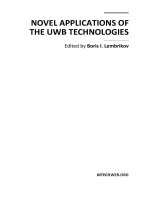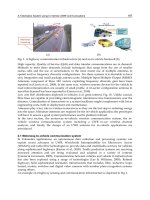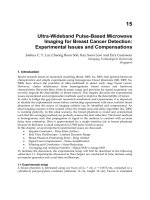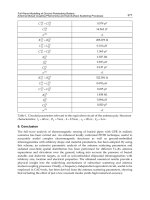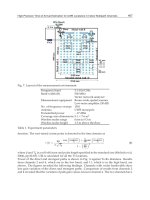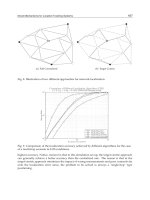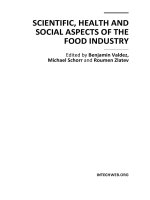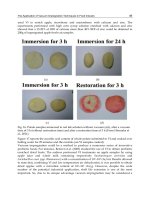Scientific, Health and Social Aspects of the Food Industry Part 1 doc
Bạn đang xem bản rút gọn của tài liệu. Xem và tải ngay bản đầy đủ của tài liệu tại đây (692.71 KB, 30 trang )
SCIENTIFIC, HEALTH AND
SOCIAL ASPECTS OF THE
FOOD INDUSTRY
Edited by Benjamin Valdez,
Michael Schorr and Roumen Zlatev
Scientific, Health and Social Aspects of the Food Industry
Edited by Benjamin Valdez, Michael Schorr and Roumen Zlatev
Published by InTech
Janeza Trdine 9, 51000 Rijeka, Croatia
Copyright © 2011 InTech
All chapters are Open Access distributed under the Creative Commons Attribution 3.0
license, which allows users to download, copy and build upon published articles even for
commercial purposes, as long as the author and publisher are properly credited, which
ensures maximum dissemination and a wider impact of our publications. After this work
has been published by InTech, authors have the right to republish it, in whole or part, in
any publication of which they are the author, and to make other personal use of the
work. Any republication, referencing or personal use of the work must explicitly identify
the original source.
As for readers, this license allows users to download, copy and build upon published
chapters even for commercial purposes, as long as the author and publisher are properly
credited, which ensures maximum dissemination and a wider impact of our publications.
Notice
Statements and opinions expressed in the chapters are these of the individual contributors
and not necessarily those of the editors or publisher. No responsibility is accepted for the
accuracy of information contained in the published chapters. The publisher assumes no
responsibility for any damage or injury to persons or property arising out of the use of any
materials, instructions, methods or ideas contained in the book.
Publishing Process Manager Masa Vidovic
Technical Editor Teodora Smiljanic
Cover Designer InTech Design Team
First published January, 2012
Printed in Croatia
A free online edition of this book is available at www.intechopen.com
Additional hard copies can be obtained from
Scientific, Health and Social Aspects of the Food Industry, Edited by Benjamin Valdez,
Michael Schorr, Roumen Zlatev
p. cm.
ISBN 978-953-307-916-5
Contents
Preface IX
Part 1 Scientific and Technological Aspects 1
Chapter 1 A Discussion Paper on Challenges and Proposals for
Advanced Treatments for Potabilization of
Wastewater in the Food Industry 3
D. B. Luiz, H. J. José and R. F. P. M. Moreira
Chapter 2 The Application of Vacuum Impregnation Techniques
in Food Industry 25
A. Derossi, T. De Pilli and C. Severini
Chapter 3 Freezing / Thawing and Cooking of Fish 57
Ebrahim Alizadeh Doughikollaee
Chapter 4 Novel Fractionation Method for
Squalene and Phytosterols Contained in
the Deodorization Distillate of Rice Bran Oil 71
Yukihiro Yamamoto and Setsuko Hara
Chapter 5 Microorganism-Produced Enzymes in the Food Industry 83
Izabel Soares, Zacarias Távora,
Rodrigo Patera Barcelos and Suzymeire Baroni
Chapter 6 Nanotechnology and Food Industry 95
Francisco Javier Gutiérrez, Mª Luisa Mussons,
Paloma Gatón and Ruth Rojo
Chapter 7 Micro and Nano Corrosion in
Steel Cans Used in the Seafood Industry 129
Gustavo Lopez Badilla,
Benjamin Valdez Salas and Michael Schorr Wiener
Chapter 8 Characteristics and Role of Feruloyl Esterase from Aspergillus
Awamori in Japanese Spirits, ‘Awamori’ Production 145
Makoto Kanauchi
VI Contents
Part 2 Social and Economic Issues 163
Chapter 9 Functional Foods in Europe: A Focus on Health Claims 165
Igor Pravst
Chapter 10 The Industrial Meat Processing Enterprises
in the Adaptation Process of Marketing Management
of the European Market 209
Ladislav Mura
Chapter 11 Facilitating Innovations in a Mature Industry-Learnings
from the Skane Food Innovation Network 221
Håkan Jönsson, Hans Knutsson and Carl-Otto Frykfors
Chapter 12 Organic Food Preference: An Empirical Study
on the Profile and Loyalty of Organic Food Customers 241
Pelin Özgen
Part 3 Health Aspects 253
Chapter 13 Yeast, the Man’s Best Friend 255
Joana Tulha, Joana Carvalho, Rui Armada, Fábio Faria-Oliveira,
Cândida Lucas, Célia Pais, Judite Almeida and Célia Ferreira
Chapter 14 Trends in Functional Food Against Obesity 279
José C.E. Serrano, Anna Cassanyé and Manuel Portero-Otin
Chapter 15 Improving Nutrition Through
the Design of Food Matrices 295
Rommy N. Zúñiga and Elizabeth Troncoso
Chapter 16 Epidemiology of Foodborne Illness 321
Saulat Jahan
Chapter 17 Allium Species, Ancient Health Food for the Future? 343
Najjaa Hanen, Sami Fattouch, Emna Ammar and Mohamed Neffati
Chapter 18 Starch: From Food to Medicine 355
Emeje Martins Ochubiojo and Asha Rodrigues
Chapter 19 Antihypertensive and Antioxidant Effects of
Functional Foods Containing Chia (Salvia hispanica)
Protein Hydrolysates 381
Ine M. Salazar-Vega, Maira R. Segura-Campos,
Luis A. Chel-Guerrero and David A. Betancur-Ancona
Chapter 20 Wine as Food and Medicine 399
Heidi Riedel, Nay Min Min Thaw Saw, Divine N. Akumo,
Onur Kütük, and Iryna Smetanska
Contents VII
Part 4 Quality Control 419
Chapter 21 Food Quality Control: History, Present and Future 421
Ihegwuagu Nnemeka Edith and Emeje Martins Ochubiojo
Chapter 22 Employment of the Quality Function Deployment (QFD)
Method in the Development of Food Products 439
Caroline Liboreiro Paiva and Ana Luisa Daibert Pinto
Chapter 23 Quality Preservation and Cost Effectiveness
in the Extraction of Nutraceutically-Relevant Fractions
from Microbial and Vegetal Matrices 463
Bravi Marco, Cicci Agnese and Torzillo Giuseppe
Preface
In a prehistoric era, human beings were moving through inhospitable grounds,
obtaining their daily sustenance by hunting and gathering fruits, seeds and roots.
Massive food production and supply started with the agricultural revolution,
paralleled with the development in the fertile valley of the rivers Tigris-Euphrates in
Mesopotamia and the Nile in pharaonic Egypt. Joseph, the son of Jacob, organized the
food stores and saved the Egyptian people during famine.
This book presents the wisdom, knowledge and expertise of the food industry that
ensures the supply of food to maintain the health, comfort, and wellbeing of
humankind. The global food industry has the largest market: the world population of
seven billion people.
This book pioneers life-saving innovations and assists in the combat against world
hunger and food shortages that threaten human essentials, such as water and energy
supply. Floods, droughts, fires, storms, climate change, global warming and
greenhouse gas emissions can be devastating, altering the environment and,
ultimately, the production of foods.
This volume is well-organized into four parts:
Scientific and technological aspects
Social and economical issues
Health aspects
Quality control
It comprises 23 chapters, arranged in a hierarchical sequence, starting with the seminal
basics of food science and technology developments, methods for food processing and
other food industry related activities. It continues with the influential role food plays
in the global society and economy, emphasizing the relevance of food to human
health. Lastly, quality control of food in all its stages of production: manufacturing,
packaging and marketing. Special articles deal with foods as medicine, particularly,
the benefits of wine to maintain health of the body and soul. Experts from industry
and academia, as well as food producers, designers of food processing equipment, and
corrosion practitioners have written special chapters for this rich compendium, based
on their encyclopedic knowledge and practical experience. This is a multi-authored
X Preface
book. The writers, who come from diverse areas of food science and technology,
enrich this volume by presenting different approaches and orientations.
The book will be useful to chemists, biologists, chemical engineers, and economists
who design, build and operate plants for food production. Also maintenance
personnel, materials, and mechanical engineers should benefit from this compendium.
University professors, researchers, and their undergraduate and postgraduate
students will use this varied book for the preparation of their thesis on food-related
projects.
Nowadays, people follow the international normative for environmental protection,
and the food industry must take care to use environmentally friendly methods in the
processing steps.
This volume is illustrated with hundreds of compact tables, well-drawn diagrams, and
clear graphs and photographs. Also valuable are the thousands of scientific and
technical references in the book from the international literature displaying the latest
advances in food science and technology.
Finally, it is our pleasant duty to express our sincere thanks to the authors for
providing their important contributions to the food industry and to this book.
Benjamin Valdez, Michael Schorr and Roumen Zlatev
Institute of Engineering
Universidad Autónoma Baja California, Mexicali,
México
Part 1
Scientific and Technological Aspects
1
A Discussion Paper on Challenges
and Proposals for Advanced
Treatments for Potabilization of
Wastewater in the Food Industry
D. B. Luiz
1,2
, H. J. José¹ and R. F. P. M. Moreira¹
¹Federal University of Santa Catarina
²Embrapa Fisheries and Aquaculture
Brazil
1. Introduction
The World Commission on Environment and Development (WCED, 1987, apud Burkhard et
al., 2000) defines sustainable development as “development that meets the needs of the
present without compromising the ability of future generations to meet their own needs''.
Sustainable production is a realistic dilemma in food industries, especially in
slaughterhouses and the meat processing industry due to the many types of processes
involved (Oliver et al., 2008; Casani et al., 2005).
Unfortunately, in many cases the implementation of environmental actions for industrial
purposes depends on large-scale economic incentives (Cornel et al., 2011). Concomitantly,
the increased costs of fresh water, wastewater treatment and waste disposal are important
economic incentives for wastewater reuse and biomass-to-energy actions in industries.
Hence, environmental, financial and social sustainability must be achieved together. Since
pollution is predominantly due to human behavior, social sustainability requires the
commitment of managers, workers and consumers (Burkhard et al., 2000).
Water scarcity is a reality in many world regions. Water pollution and overexploitation,
climate change, urbanization, industrialization and increases in the world population and,
consequently, food consumption and production are the main factors aggravating the global
fresh water crisis (EPA, 2004; Clevelario et al., 2005; Khan et al., 2009; Luiz et al., 2009, 2011).
Hence, sustainability in water and wastewater management is a current requirement of
industries in order to promote the minimization of fresh water consumption and reduction
of wastewater production preserving high-quality groundwaters (Cornel et al., 2011).
Concerning the water consumption in food industries, this input is mostly used for cleaning
and disinfection, cooling and heating (Oliver et al., 2008), and also for processing food for
human consumption and for sanitary uses. International organizations (e.g. Codex
Alimentarius, 2001, 2007) have recognized and stimulated the implementation of direct and
indirect wastewater reuse and indirect potable reuse with techniques that take into account
hygienic concerns (Casani et al., 2005) to avoid risking adverse effects on the product
Scientific, Health and Social Aspects of the Food Industry
4
integrity, the environment and the health of workers and customers. However, these
procedures will be universal in the near future.
Currently, conventional wastewater techniques are not satisfactory to produce reuse
wastewater with drinking water quality, further procedures being necessary. Advanced
oxidation processes (AOPs) are the most suitable tertiary treatment. AOPs are based on
chemical oxidation and can degraded any kind of organic matter with highly reactive and
non-selective radicals, mainly hydroxyl radicals (•OH) (Oller et al., 2010; Luiz et al., 2010).
AOPs can involve a combination of strong oxidants (e.g. O
3
and H
2
O
2
), ultraviolet (UV),
semiconductor catalysts (e.g. TiO
2
and ZnO) and ultrasound (15 kHz to 1 MHz), and the
most common examples are: H
2
O
2
/UV, H
2
O
2
/O
3
, H
2
O
2
/O
3
/UV, O
3
/UV, TiO
2
/UV,
H
2
O
2
/catalyst, Fenton (Matilainen and Sillanpää, 2010).
There are many studies and reviews on advanced processes to treat secondary wastewater
from industries which also address the challenges and limitations to water reuse and the
hygienic concerns especially in food industries. However, the challenges associated with
treating a secondary wastewater to provide drinking water quality become clear when real
wastewater is treated in batch and in pilot scale. The limitations are several, particularly in
food industries. Hence, this review aims to present an overview and a discussion regarding
the challenges and proposals related to the advanced treatment of food industry wastewater
to provide drinking water quality, elucidating some experimental and theoretical questions
surrounding such processes. Valuable experimental advice which is not usually found in
research papers will be provided, for instance, which oxidation treatment should be chosen,
which initial experiments should be carried, and which methodology should be followed to
evaluate the kinetics constants in different situations will be provided, along with
methodology issues. Some previous papers by the authors will be discussed and also some
unpublished data on experiences in slaughterhouses and the meat processing industry. The
oxidation treatments discussed are ozonation and many AOPs; ultraviolet treatment will
also be addressed.
Due to the wide variety of processes and food products, food-processing wastewater can be
a complex mixture, and this must be taken into account when considering the recycling,
reuse, reconditioning for recycling or reuse, treatment or disposal of water. It is known that
the segregation of wastewater streams in at an industrial plant – separating the effluent of
each process – or at least the combining of the most similar streams in terms of physical-
chemical and microbiological characteristics, enables an optimal treatment for each type of
wastewater, energy savings, greater efficiency and lower cost of disposal and reuse.
Nevertheless, in most plants the wastewater from all process – including from the toilets –
are collected together, making the treatment difficult and costly. Hence, ascertaining the
basic nature of food industry wastewater and its variability is the first challenge. This
information is important to selecting the best combination of processes through which to
treat the effluent.
Besides the need to remove minerals (by filtration) and organic matter, it is also necessary
eliminate nitrogen compounds, especially in the dairy and meat industries. Advanced
oxidation processes can remove simultaneously organic matter and nitrate; however, there
are many parameters that should be taken into account, e.g., concentration of organic
compounds and oxygen-free media. Some industrial plants also need to remove a specific
recalcitrant organic compound which can be oxidized by advanced treatments; however, the
A Discussion Paper on Challenges and Proposals for
Advanced Treatments for Potabilization of Wastewater in the Food Industry
5
effectiveness of the treatment is mainly dependent on whether the oxidant is selective or
non-selective, the presence of oxidant scavengers and the dosage of oxidant.
Given that the growing demand for water, limited access to water in some regions and
increased concern regarding the environmental impact of industrial activities on the
environment are aspects driving the research on and implementation of water reuse in
industrial plants, the theme discussed in this review will be of interest to several fields of
chemistry, as well as food, chemical and environmental engineering.
2. UV radiation
UV radiation can degrade organic compounds via two routes: direct photolysis and photo-
oxidation via radical generation. In the first route, direct photolysis or photodegradation,
the efficiency is directly related to the ability of the target organic compound to absorb UV
radiation at the wavelength used (λ) (Beltran et al., 1993). The UV absorption leads to direct
excitation and the breakdown of organic pollutants (Rincón; Pulgarin, 2006). Lau et al. (2007)
leading to the formation of excited radicals (R•) by UV excitation of organic compounds
(RH). These radicals can be converted into stable molecules (dimers) via a dimerization
process (Equations 1-6) which is favored by the presence of O
2
in water. If the free radical
chain is interfered with (termination reactions, Equations 4-6), UV treatment may be less
effective (Lau et al., 2007).
Initiation:
RH R H
hv
• •
→ +
(1)
Propagation:
2
R O ROO
• •
+ →
(2)
RH ROO ROOH R
• •
+ → +
(3)
Termination:
2
ROO ROO ROOR O
• •
+ → +
(4)
ROO R ROOR
• •
+ →
(5)
R R RR
hv
• •
+ →
(6)
According to Beltran-Heredia et al. (2001), for pH <7.0, the rate of photodecomposition
increases with increasing pH, which may be due to an increase in the generation of free
radicals (R•) (Equations 1-3).
The second route is photo-oxidation via oxidative processes by radical generation. When
natural water matrices are used, the presence of nitrate, iron (III) and/or organic matter can
provide •OH due to photo-oxidation of these compounds by UV or other AOP in
combination with UV, such as UV/H
2
O
2
, UV/O
3
, UV/H
2
O
2
/O
3
.
Scientific, Health and Social Aspects of the Food Industry
6
Nitrate ions absorb UV radiation by acting as an internal filter to UV light and, in parallel,
can form •OH through the mechanism detailed below (Equations 7-11) (Neamtu and
Frimmel, 2006).
3 2
NO NO O
hv
− −
→ +
(7)
3 2
NO NO O
hv
− • − •
→ +
(8)
2 2 2 3
2NO H O NO NO 2H
• − − +
+ → + +
(9)
2
O H O 2 OH
+ → •
(10)
2
O H O OH HO
− • −
+ →• +
(11)
For wavelengths longer than 300 nm, complex aqueous ferric iron Fe(OH)
2
+
, Fe(OH)
4
-
,
Fe(OH)
2+
, Fe
3+
, Fe
2
(OH)
2
4+
) can generate ferrous ions and •OH radicals by photolysis
through the internal transfer of electrons (Equation 12) (Espinoza et al., 2007).
2 2
Fe(OH) Fe HO
hv
+ + •
→ +
(12)
Dissolved organic matter absorbs UV light and can generate reactive radicals such as singlet
oxygen, superoxide anions (•O
2
-
), •OH radicals and peroxyl radicals (ROO•). These
reactive transients can degrade organic pollutants following different paths, and
consequently they are not degraded only by direct photolysis (Chin et al. 2004; Neamtu and
Frimmel, 2006).
The UV radiation is also used for disinfection, especially of reuse water. Ultraviolet
radiation is bactericidal because it causes damage to the nucleic acids (DNA and RNA) of
microorganisms (bacteria and viruses), inactivating them. Consequently, UV radiation
prevents micro-organisms from multiplying because the photoproducts formed from
nucleic acids (e.g., pyrimidine dimers) inhibit replication and transcription (Achilleos et al.,
2005). The peak absorbance of nucleic acid is around 260 nm, but below 230 nm absorbance
is also high. UV lamps, most of which emitted light at 254 nm (low pressure mercury lamps)
are commonly used in studies on the disinfection of aqueous matrices, but polychromatic
UV lamps can also be effective in inactivating certain microorganisms (Hijnen et al., 2006).
The use of UV disinfection is increasing mainly due to the fact that it is less expensive than
chlorine disinfection, safer than chlorine gas, does not form organochlorine and is effective
against
Cryptosporidium
and
Giardia
, while chlorine is not. Additionly, UV disinfection does
not form by-products or residual toxicity, and has a low regrowth of bacteria. However, UV
radiation requires water with low turbidity to allow the radiation to be effective (Achilleos
et al., 2005).
As solar radiation is composed of approximately 4% of UVA/UVB (295-400 nm), besides
visible light (400-800 nm) and infrared radiation, this natural radiation has been used for
disinfection, color reduction and dissolved organic matter removal in surface waters
(Kulovaara et al., 1995, Martín-Domínguez et al., 2005, Davies et al., 2009).
A Discussion Paper on Challenges and Proposals for
Advanced Treatments for Potabilization of Wastewater in the Food Industry
7
3. Ozonation
Ozone decomposes to oxygen after generation, so it cannot be stored and must be generated
on-site. As this oxidant is a gas with low solubility in water (1.05 g L
-1
), the efficiency of the
gas–liquid transfer of ozone is the main variable affecting the effectiveness of organic
compound oxidation by ozone in water matrices (Sievers, 2011). The main decomposition
reactions of ozone in pure water at ambient temperature (around 20°C) are Equations 13-23.
Initiation:
O
ଷ
+
OH
ି
⟶
HO
ଶ
ି
+
O
ଶ
k = 70 M
-1
s
-1
(Staehling; Hoigne, 1982) (13)
k = 48 M
-1
s
-1
(Forni et al., 1982)
Propagation:
O
ଷ
+
HO
ଶ
ି
⟶
∙
OH
+
O
ଶ
ି
∙
+
O
ଶ
k = 2,8 x 10
6
M
-1
s
-1
(Staehling; Hoigne, 1982) (14)
O
ଷ
+
O
ଶ
ି
∙
⟶
O
ଷ
ି
∙
+
O
ଶ
k = 1,6 x 10
9
M
-1
s
-1
(Bühler et al., 1984) (15)
ሺ
pH
≥
8
ሻ
O
ଷ
+
O
ଶ
ି
∙
⇌
O
ଷ
ି
∙
+
O
ଶ
k
+
= 1,9 x 10
3
s
-1
(Elliot; McCracken, 1989) (16)
k
-
= 3,5 x 10
9
M
-1
s
-1
(Elliot; McCracken, 1989)
O
ି
∙
+
H
ଶ
O
⟶
∙
OH
+
OH
ି
k = 10
8
s
-1
(von Gunten, 2003a) (17)
ሺ
pH
≤
8
ሻ
O
ଷ
ି
∙
+
H
ା
⇌
HO
ଷ
∙
k
+
= 5,2 x 10
10
M
-1
s
-1
(Bühler et al., 1984) (18)
k
-
= 3,3 x 10
2
s
-1
(Bühler et al., 1984)
H
O
ଷ
∙
⟶
∙
OH
+
O
ଶ
k = 1,1 x 10
5
s
-1
(Bühler et al., 1984) (19)
O
ଷ
+
∙
OH
⟶
∙
HO
ଶ
∙
+
O
ଶ
k = 3,0 x 10
9
M
-1
s
-1
(Bahnemann; Hart, 1982) (20)
HO
ଶ
ି
+
H
ା
⇌
H
ଶ
O
ଶ
pK
a
= 11,7 ± 0,2 (Behar et al., 1970) (21)
HO
ଶ
∙
⇌
H
ା
+
O
ଶ
ି
∙
pK
a
= 4,8 (Behar et al., 1970) (22)
K
equilíbrio
= 1,3x10
-5
M
-1
(Behar et al., 1970)
∙
OH
⇌
O
ି
∙
+
H
ା
pK
a
= 11,84 (Elliot; McCracken, 1989) (23)
Where pK
a
is the acid dissociation constant. The termination reactions are any reactions
between •O
2
-
,•O
3
-
, HO
2
-
, HO
2
• and •OH (Bühler et al. 1984; Nadezhdin, 1988).
Analyzing the mechanism described above (Equations 13-23), it appears that the
decomposition of ozone can be accelerated by increasing the pH, since hydroxyl ions (OH
-
)
(Equation 13) start this process and the HO
2
-
concentration is pH-dependent (Equation 21)
(Andreozzi et al., 1999). As the decomposition of ozone leads to the formation of H
2
O
2
(Equation 21), the addition of hydrogen peroxide will promote the decomposition of ozone
and increase the formation of •OH. Therefore, the combination O
3
+H
2
O
2
provides the
advanced oxidation process (AOP) O
3
/H
2
O
2
.
Scientific, Health and Social Aspects of the Food Industry
8
In the decomposition reactions (organic matter oxidation reactions), there are two
mechanisms: direct attack of ozone and free radical attack. The direct attack of ozone is
selective and usually occurs in the case of unsaturated compounds (carbon-carbon double or
triple bonds -
π
bonds), aromatic rings, amines and sulfides (von Gunten, 2003a). The
primary reaction of ozone with a certain compound (
C
) occurs through the generation of an
electrophilic additional intermediate compound (
C
-O
3
) which decomposes via consecutive
reactions until the formation of stable compounds (von Gunten, 2003a).
The direct attack of ozone on tertiary amine occurs by hydrolysis and demethylation,
generating the corresponding aldehyde and secondary amine, which is the most stable
compound containing the nitrogen atom. Similarly, the same reactions occur with the
secondary and primary amine until the formation of the most stable organic compound
(Muñoz and von Sonntag, 2000, Lange et al., 2006, Luiz et al., 2010). The oxidation of
ammonia through direct attack by ozone is very slow, but it generates the same product as
the radical attack: NO
3
-
. The replacement of hydrogen atoms by alkyl groups (C
n
H
2n+1
) in
the amine nitrogen increases the rate constant of oxidation via ozone (
k
). The
k
value for
oxidation via ozonation of ammonia (NH
3
) is 20 M
-1
s
-1
, of diethylamine is 9.1 x 10
5
M
-1
s
-1
and of triethylamine is 4.1 x 10
6
M
-1
s
-1
(von Gunten, 2003a).
In the radical attack, radical ions are formed during the oxidative degradation of ozone in
water, the main ones being: oxygen free radical (O-•), superoxide radical (•O
2
-) and
hydroxyl radical (•OH) (Hoigné; Bader, 1983, Luiz et al., 2010).
The free radical attack is usually faster than the direct attack of ozone. However, in an
ozonation process, the concentration of ozone is higher than that of its degradation radicals
and hence the oxidation is mainly due to molecular attack. There are molecules that are
slowly degraded by ozone treatments (because the molecular attack is selective) and rapidly
degraded in advanced oxidation processes in which the attack by •OH radicals
predominates (non-selective, higher removal efficiency and the mineralization of organic
compounds) (Lau et al., 2007). Therefore, in tertiary wastewater treatment, it is necessary to
know which organic contaminants are present in the wastewater in order to verify whether
they can be oxidized by simple ozonation or if an AOP would be more effective.
Ozone is a powerful disinfectant, causing cell inactivation through direct damage to the
membrane and cell wall, disruption of enzymatic reactions and DNA damage, including in
the case of highly resistant pathogens such as protozoan
Cryptosporidium parvum
(EPA, 2004;
von Gunten, 2003b). Compared with chlorination, disinfection with ozone is a better option
for water bodies which are not organochlorine receivers and its excess can be easily
dissipated (Achilleos et al. 2005; EPA, 2004). However, since the concentration required to
inactivate the most resistant organisms is very high, there may be the formation of non-
desirable disinfection by-products, especially bromates which have carcinogenic potential
(von Gunten, 2003b).
4. Advanced oxidation processes (AOP)
Advanced oxidation processes (AOPs) degrade organic contaminants into carbon dioxide,
water and inorganic anions through the action of transient oxidizing species, especially
hydroxyl radicals (•OH). AOPs are clean processes because they do not generally require
post-treatment or the final disposal of potential waste.
A Discussion Paper on Challenges and Proposals for
Advanced Treatments for Potabilization of Wastewater in the Food Industry
9
The •OH radicals are not selective, thus they have the ability to degrade all organic
substances present in a liquid or gas to be treated. The abstraction of H for the reaction of
•OH and organic compounds in the presence of saturated oxygen is the main route for the
shortening of the chains of ketones, aldehydes and carboxylic acids (Mellouk et al., 2003).
4.1 UV/H
2
O
2
Ultraviolet (UV) treatment promotes photolysis (or photo-oxidation) of organic compounds.
To achieve a greater degradation, there are processes that combine UV radiation with other
chemical agents such as O
3
and H
2
O
2
(Parkinson et al., 2001). Among the variety of AOPs
available and their combinations, the reagent H
2
O
2
is frequently used due to its stability
during transport and storage, almost infinite solubility in water, and low installation and
operation costs compared to other processes, such as the application of O
3
(Alfano et al., 2001).
In UV/H
2
O
2
treatment, radiation with a wavelength shorter than 300 nm (UV-C irradiation)
breaks H
2
O
2
into
●
OH radicals (Equation 24) which oxide the pollutant compounds.
However, for the organic compound degradation to be effective, and mineralization of the
compounds to occur (into CO
2
and H
2
O), the H
2
O
2
concentration must be above the
stoichiometric demand and the reaction time under UV radiation must be sufficient, as
previously determined experimentally (Alfano et al., 2001).
The photolysis of water yields dissolved oxygen (Equation 24) which can favour the
photodegradation of organic compounds (Equation 2). Nevertheless the photolysis of
hydrogen peroxide by UV radiation promotes the formation of stronger oxidants: hydroxyl
radicals (●OH) (Equation 25). The mechanism of AOP UV/H
2
O
2
treatment includes
initiation, propagation and termination reactions, and degradation reactions of the organic
compounds (RH) (Equations 25-32) (Alfano
et al
., 2001).
hv
-
2 2
2H O O 4H 4e
+
→ + +
(24)
Initiation:
hv
2 2
H O 2 OH
•
→
(25)
Propagation:
2
k
2 2 2 2
H O OH HO H O
• •
+ → +
(26)
3
k
2 2 2 2 2
H O HO OH H O O
• •
+ → + +
(27)
Termination:
4
k
2 2
2 OH H O
•
→
(28)
5
k
2 2 2 2
2HO H O O
•
→ +
(29)
Scientific, Health and Social Aspects of the Food Industry
10
6
k
2 2 2
OH HO H O O
•
•
+ → +
(30)
Decomposition:
7
k
RH OH products
•
+ →
(31)
8
k
2
RH HO products
•
+ →
(32)
The propagation (Equations 26-27) and termination (Equations 28-30) reactions indicate that
when there is H
2
O
2
in excess and, subsequently, an excess of •OH radicals, the recombination
of these radicals is favored (Equation 28) reversing the initiation reaction (Equation 25) and
inhibiting the oxidation reactions of organic compounds (Equations 31-32).
Yang et al. (2005) found that there is no significant effect of pH on the degradation efficiency
if the treatment is only via photodegradation by UV radiation. However, in a UV/H
2
O
2
reaction the generation of hydroxyl radicals (
●
OH) may be affected by the presence of high
concentrations of H
+
and OH
-
. Many authors have observed higher rates of decomposition
of organic contaminants at low pH (Song et al., 2008). However, Yang et al. (2005) found the
efficiency of mineralization of the complex sodium ethylenediamine tetraacetic acid (Na-
EDTA) decreased from 98% (in ultra-pure water and without pH correction) to around 70%
with initial pH values of 2.3 and 11.6, respectively.
The commercial and industrial applications of UV/H
2
O
2
processes require the
determination of optimal oxidant and irradiation dosages. Therefore, the development of a
mathematical model for these processes can help the determination of such variables
(Crittenden et al., 1999). Usually, the kinetic model used for common pollutants in aqueous
solutions is a pseudo-first-order model by photodegradation (UV radiation) and also by the
AOP H
2
O
2
/UV (Chen et al. 2007; Song et al. 2008; Luiz et al., 2009).
Dosages below 15 mg L
-1
of hydrogen peroxide do not have a significant toxic effect on
bacteria when the system is not exposed to light (in darkness) (Rincón; Pulgarin, 2006;
Sciacca et al., 2010). However, hydrogen peroxide in the extracellular region weakens the
cell walls, making the bacteria more sensitive to oxidative stress and this may explain the
observed inactivation at lower concentrations. Therefore, although H
2
O
2
is not directly toxic
to the bacteria, the cleavage products, for instance, the hydroxyl (•OH) and superoxide
(HO
2
• and •O
2
-
) radicals generated by the addition of another agent in the system, such as
UV, O
3
, ferric or ferrous ions (Fenton reaction) (Sciacca et al., 2010) can be toxic. Such species
can induce reactions in lipids, proteins and DNA, inactivating the cells.
4.2 O
3
/H
2
O
2
, O
3
/UV and O
3
/H
2
O
2
/UV
The AOPs O
3
/H
2
O
2
, O
3
/UV and O
3
/H
2
O
2
/UV have been developed to treat wastewater
highly contaminated by both organic matter and microorganisms. The effectiveness of these
treatments is due to synergistic interaction of the positive effects of three reactions: direct
ozonation (molecular attack), photolysis and oxidation by hydroxyl radicals (•OH) (Lau et
al., 2007, Luiz et al., 2010). Some important factors, such as quantifying the speed of photons
A Discussion Paper on Challenges and Proposals for
Advanced Treatments for Potabilization of Wastewater in the Food Industry
11
absorbed in the heterogeneous medium (ozone gas in water matrices), and assessing the
degree of ozone reactivity with unsaturated organic compounds, still need to be better
understood (Legrini et al., 1993).
The mechanism of the AOPs O
3
/H
2
O
2
, O
3
/UV and O
3
/H
2
O
2
/UV are very similar to each
other, and all have the hydroxyl radical (•OH) as the most important intermediate
compound (Beltran et al. 1995; Legrini et al., 1993). In the AOP O
3
/H
2
O
2
, besides the
initiation reaction of ozone decomposition, another initiation reaction is the decomposition
of hydrogen peroxide by ozone into hydroxyl radicals (Equation 33). The decomposition of
hydrogen peroxide by ozone (Equation 33) is very slow (Legrini et al., 1993), but it enhances
the other ozone decomposition reactions which generate more •OH radicals (Equations 13-
23). Therefore, the reaction rate can be increased with increasing the pH, because the ionic
form of H
2
O
2
(HO
2
-
) reacts with O
3
(Staehelin; Hoigné, 1982) (Equation 14) followed by other
reactions of propagation, termination and decomposition.
3 2 2 2 2
O H O O HO OH
• •
+ → + +
(33)
The absorbance spectrum of ozone indicates that it has a greater absorption at 254 nm than
H
2
O
2
, 3300 and 18.6 M
-1
cm
-1
, respectively, and the influence of the internal effects of the
system is lower in an O
3
/UV system, due to the effect of suspended solids and aromatic
compounds which can act as a UV filters. Nevertheless, the quantum yield of •OH radicals
in the AOP O
3
/UV (around 0.1) is lower than in H
2
O
2
/UV (Sievers, 2011). The quantum
yield of a photochemical reaction is the number of events divided by the number of
absorbed photons of a specific wavelength during the same period time (Khun et al., 2004).
The absorption of UV light by O
3
in water leads, firstly, to the generation of H
2
O
2
(Equation
34) (Legrini et al., 1993). Therefore, the other reactions of propagation, termination and
decomposition are all cited for O
3
treatments, and for O
3
/H
2
O
2
H
2
O
2
/UV (Equations 14-33).
hv
3 2 2 2 2
O H O H O O
+ → +
(34)
The AOP O
3
/H
2
O
2
/UV should be used to enhance the generation of hydroxyl radicals, as its
initiation reactions are the same as those of ozonation, H
2
O
2
/UV, O
3
/H
2
O
2
and O
3
/UV
(Equations 13, 25, 33 and 34). All other reactions are of the types propagation, termination
and decomposition (Equations 14-32).
AOPs promote a higher degree of mineralization compared to other tertiary oxidative
treatments (such as simple ozonation), ensuring decreased levels or the absence (if the
mineralization is total) of oxidized intermediate products that, usually, reduce the initial
toxicity (Rosal et al., 2008).
4.3 Homogeneous fenton and fenton-like pocess
A widespread AOP is the homogeneous Fenton process involving the reaction of hydrogen
peroxide (H
2
O
2
) with the Fenton catalyst (ferrous ion - Fe(II) - dissolved in acid aqueous
media) generating hydroxyl radicals (•OH) and ferric ions (Fe(III)). Fe(III) ions undergo
reduction to Fe(II) mainly through the action of the oxidant H
2
O
2
ensuring the continuation
of the catalytic reaction. The main reactions of the Fenton process are represented by
Equations 35 to 41 (Garrido-Ramirez et al. 2010; Herney-Ramirez et al. 2010; Navalon et al.,
2010, Umar et al., 2010).
Scientific, Health and Social Aspects of the Food Industry
12
2 3
2 2
Fe H O Fe OH OH
+ + −
+ → + +
(35)
3 2
2 2 2
Fe H O Fe HO H
+ + +
+ → + +
(36)
2 2 2 2
OH H O HO H O
+ → +
(37)
2 3
OH Fe Fe OH
+ + −
+ → +
(38)
3 2
2 2
Fe HO Fe O H
+ + +
+ → + +
(39)
2 3
2 2 2
Fe HO H Fe H O
+ + +
+ + → +
(40)
2 2 2 2
2HO H O O
→ +
(41)
There are many variations of the Fenton process and the main ones are:
• Modified Fenton or Fenton-like reaction: ferric ion or another transition metal (such as
copper) is used instead of ferrous ion (Herney-Ramirez et al., 2010);
• Heterogeneous Fenton: supported catalyst is used in a solid matrix (heterogeneous
system);
• Photo-Fenton: the regeneration of Fe(II) is accelerated due to photoreduction of Fe(III),
and the generation of hydroxyl radicals is increased due to the photolysis of hydrogen
peroxide (Equation 25) (Umar et al., 2010);
• Electro-Fenton: continuous generation of H
2
O
2
in acidic solution by reducing gaseous
O
2
in carbon cathodes (Sirés et al., 2007);
Other variations: heterogeneous Fenton-like, heterogeneous photo-Fenton, Photo-Fenton-
like, and heterogeneous Photo-Fenton-like processes.
Equation 42 describes the Fenton reaction and its variations should occur at acid pH
through the occurrence of hydrogen peroxide decomposition in the presence of a ferrous ion
catalyst (Umar et al., 2010).
2 3
2 2 2
2 2 2 2
Fe H O H Fe H O
+ + +
+ + → +
(42)
The homogeneous Fenton process is carried out in four stages: (1) pH adjustment (optimal pH
is around 2.8), (2) oxidation reaction through the action of oxidizing radicals (especially •OH),
(3) neutralization followed by coagulation (formation of ferric hydroxide complexes), and (4)
precipitation (Umar et al., 2010). Therefore, the organic substances are removed by oxidation
and by coagulation. Thus, the homogeneous Fenton process has the great disadvantage of
producing, at the end of the process, solid waste (sludge) with a high metal concentration,
generating environmental risks and extra costs due to the post-treatment of sludge to recover
A Discussion Paper on Challenges and Proposals for
Advanced Treatments for Potabilization of Wastewater in the Food Industry
13
part of the catalyst (Herney-Ramirez et al., 2010, Umar et al., 2010). Hence, the heterogeneous
Fenton process eliminates the step of catalyst precipitation and removal at the end of the
process (Garrido-Ramirez et al. 2010; Herney-Ramirez et al. 2010 ; Navalon et al., 2010).
Among the various factors that affect the efficiency of the Fenton process, pH and the
H
2
O
2
/Fe(II) ratio are the most important ones. In reactions with a low H
2
O
2
/Fe(II) ratio,
chemical coagulation is predominant in the removal of organic matter, whereas with high
ratios the chemical oxidation is dominant (Umar et al., 2010).
4.4 Heterogeneous AOPs
The heterogeneous AOPs using a semiconductor as the catalyst and ultraviolet radiation
have the advantage of not requiring the addition of a strong oxidant to produce hydroxyl
radicals (photocatalysis process, e.g., the AOP TiO
2
/UV). However, the addition of an
oxidant can accelerate the production of oxidizing radicals and increase the speed of organic
matter removal (e.g. the AOP TiO
2
/UV/H
2
O
2
).
Photocatalysis is the catalysis of a photochemical reaction on the surface of a solid, usually a
semiconductor, TiO
2
being the most used (Fujishima et al., 2008). In this reaction the
oxidation of organic pollutants occurs in the presence of an oxidizing agent, followed by
activation of a semiconductor with light energy (Ahmed et al., 2010) at wavelengths ≤ 400
nm (Malato et al., 2009).
The catalyst is activated when it absorbs photons with energies greater than the value of
its "band gap" energy resulting in the excitation of electrons from the valence band to the
conduction band forming a hole (h
+
) in the valence band. This hole promotes the
oxidation of pollutants (in the case of photo-catalytic oxidation of organic pollutants) or
water, in the latter case producing hydroxyl radicals (OH •). The electron (e
-
) of the
conduction band reduces the oxygen or other oxidative agent in the absence of O
2
(Ahmed et al., 2010). The oxidizing agent binds to the conduction band, where the
reduction occurs through the gaining of electrons (e
-
), while the organic compound to be
degraded binds to the valence band, where oxidation occurs, donating e
-
and receiving h
+
.
Thus the organic compound is the reducing agent or electron donor (hole scavenger)
(Malato et al., 2009).
Photocatalysis is an AOP because, during the photochemical reactions and the activation of
the catalyst, hydroxyl radicals are formed (Malato et al., 2009, Hermann, 2010). Hence, these
treatments may reduce the toxicity of wastewaters by total or partial mineralization of
synthetic organic compounds transforming them into more biodegradable substances.
There are photocatalytic processes using solar energy, representing a Green Chemistry
technology approach (Hermann, 2010), with the following benefits: 1) process carried out at
ambient temperature and pressure, 2) the oxidizing agent can be oxygen obtained from the
atmosphere, 3) many catalysts are low-cost, safe and reusable, and 4) use of solar energy as
an energy source (Malato et al., 2009).
5. Water and wastewater management
Prior to the implementation of a tertiary process for wastewater treatment aiming at water
reuse to reduce the consumption of fresh drinking water, it is essential to minimize and to
optimize the water consumption in all processes of an industrial plant. Thus, it is essential to


